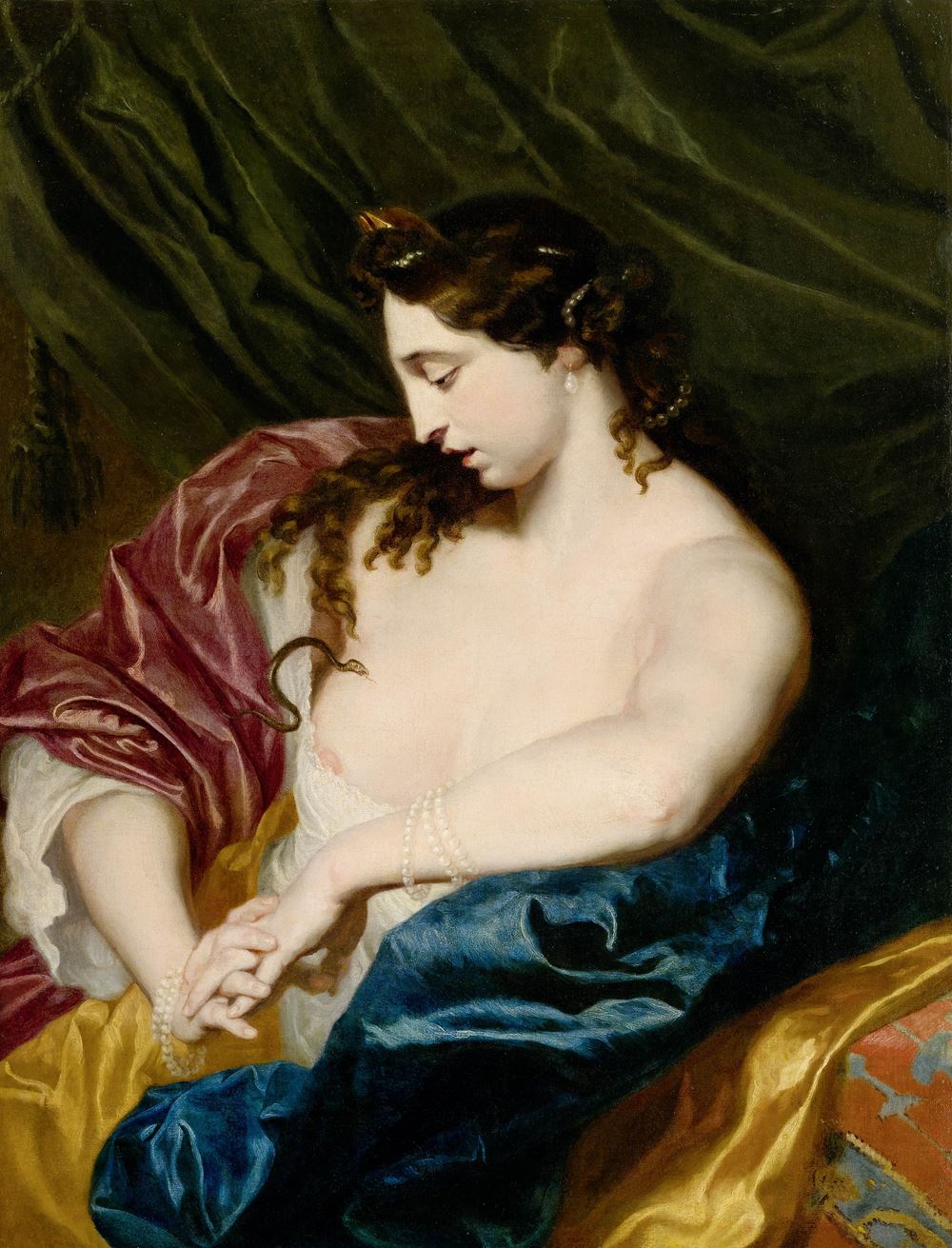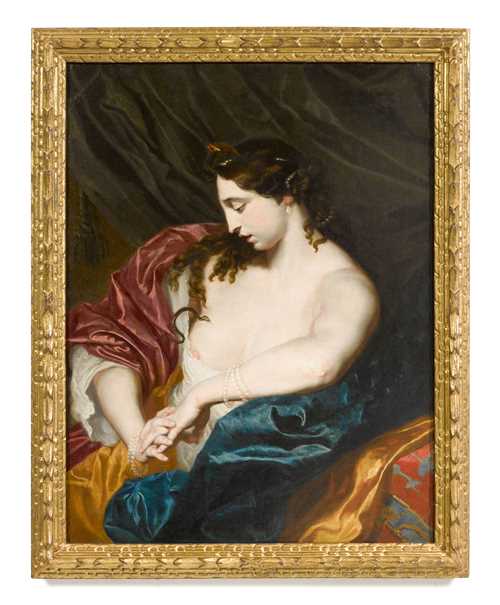
Lot 3032* - A204 Tableaux de Maîtres Anciens - vendredi, 31. mars 2023, 14h00
MATTHÄUS MERIAN the Younger.
- Probably collection of Count Johannes Septimius Jörger von Tollet (1594–1662).
- Sale Christie's, London, 9.12.1993, lot 62 (as circle of Gérard de Lairesse).
- European private collection.
- Sale Bonhams, London, 29.4.2015, lot 176 (as Flemish School, 17th century).
- European private collection.
Literature:
Jahel Sanzsalazar, I Am Cleopatra. The Seduction and Stoicism of a Newly Identified Painting by Matthäus Merian the Younger (1621–1687), in: Zeitschrift für Kunstgeschichte, Issue 1, 2019, 82nd year, pp. 71–92.
The painting offered here is an important new discovery which sheds light on Matthäus Merian's entire oeuvre. While his father Matthäus Merian the Elder (1593–1650) is well known to this day as an engraver and publisher, and the oeuvre of his sister Maria Sibylla (1647–1717) has also become the focus of art historical research in the wake of the increased interest in women artists, the acquisition of Merian's self-portrait by the Historisches Museum Frankfurt in 2008 attests to the new awareness and appreciation of this artist.
Matthäus Merian the Younger is known as a pupil of Joachim von Sandrat (1606–1688), with whom he created altarpieces while also working as an engraver. At the age of 18 he joined Anthonis van Dyck's (1599–1641) workshop in London in 1639. After Van Dyck's death he moved to Paris, where he explored the classicist styles of Philippe de Champaigne (1602–1674), Simon Vouet (1590–1649) and Nicolas Poussin (1594–1665). From 1643 to 1647, he travelled through Italy and visited the most important art centres of the time, including Venice, Rome and Naples. There the works of Guido Reni (1575–1642) and José de Ribera (1591–1652) in particular aroused Merian's interest. After his return to Frankfurt he took over his father's publishing house and received numerous official commissions for portraits, which brought him great renown.
While a considerable number of those portraits still survive, only three historical-mythological works have come down to us today: the painting ‘Vertumnus and Pomona’ (oil on canvas, 186 x 130 cm, private collection, Barcelona) and two versions of ‘Artemisia’ (1647, oil on canvas, Museum of Art and Archaelogy, University of Missouri at Columbia; 1655, oil on canvas, 133.3 x 120.3 cm, Anhaltische Gemäldegalerie in Dessau). Consequently, these are considered key works within this lesser-known facet of Merian's oeuvre, while at the same time illustrating his innovative potential in this field and demonstrating his closeness to his former teacher Van Dyck in terms of technique and elegance.
Based on stylistic comparisons with these three well-known works, Dr Jahel Sanzsalazar identifies our painting as the work of Matthäus Merian the Younger (see Literature). Parallels in style and motif can also be found in the ‘Portrait of the Merian Family’ in the Kunstmuseum Basel (inv. no. 2318, circa 1642–43, oil on canvas, 118.5 x 140 cm). A similar oriental carpet is used there and employed to great effect to provide spatial structure.
Supporting the stylistic comparisons, Merian's engraving ‘Cleopatra with the Asp’ (Fig. 1, after 1656–1657, 23.7 x 17.8 cm, Stuttgart, Staatsgalerie, Graphische Sammlung , inv. no. An 2205) also confirms its authorship. One of the artist's finest engravings, so far it has not been possible to connect it with any painting, although the mirror image suggests that the engraving was made after our painting. As the caption of the engraving reveals, it was dedicated to Count Johannes Septimius Jörger von Tollet (1594–1662). He had made a name for himself as a passionate art collector and was a close friend of the Merian family. Jahel Sanzsalazar considers it probable that our painting once belonged to him too, and could have been sold by his son in 1667 when the family fell into debt.
According to Sanzsalazar, the stylistic analogies to the two versions of Artemisia (1647 and 1655) and to the painting ‘The Martyrdom of Saint Catherine’ (1653) as well as the dating of the aforementioned engraving, speak in favour of dating the present painting to the 1650s.
In addition to the dedication to Jörger, the Latin inscription on the engraving also contains a poem by Merian as a moral warning against the pitfalls of love. As in our painting, Merian depicts Cleopatra as the embodiment of the seductive femme fatale to whom all men fall prey. In doing so, the two depictions skilfully reflect the ambiguity that surrounds the traditional understanding of Cleopatra and which inspired both literature and art: Cleopatra, who was the last queen of the Egyptian Ptolemaic Empire and at the same time the last female pharaoh to rule from 51 BC to 30 BC, wanted to expand her empire. To this end, she succeeded in winning over the two most powerful Romans of her time as her lovers, first Gaius Iulius Caesar and, after Caesar’s assassination, Marcus Antonius (Marc Antony), and, with their help, significantly improved the standing of the Ptolemaic Empire for some time. Antony's defeat by the later Emperor Augustus meant the end of her rule. Cleopatra and Antony committed suicide and Egypt became the Roman province of Aegyptus.
While ancient authors describe our protagonist as a historical-political figure and interpret her suicide as cowardice, in the 16th century her image was rehabilitated by Dante and Boccaccio, who idealised the figure of Cleopatra as a heroine and martyr who chose suicide out of dignity and pride. In the 17th century, authors begin to paint a more human vision of Cleopatra, understanding her in all her various aspects, the most egregious vices and the most sublime virtues. Her suicide is interpreted as an act of freedom and a sign of her unremitting love. Subsequently, she became a model of moral constancy, which was idealised as a higher virtue within the neo-Stoicism of Justus Lipsius.
A convinced neo-Stoicist, Merian depicts Cleopatra in stoic repose and anticipation of her death, without any hint of pathos or suffering. Instead, he portrays a woman who seems almost at ease in her predicament. Her eyes lowered, she looks towards the serpent and awaits it with clasped hands. Merian consequently shows Cleopatra as a majestic, but not untouchable queen, rather as a woman who invites us to witness her gentle poisoning.
CHF 60 000 / 80 000 | (€ 61 860 / 82 470)
Vendu pour CHF 73 500 (frais inclus)
Aucune responsabilité n'est prise quant à l´exactitude de ces informations.


